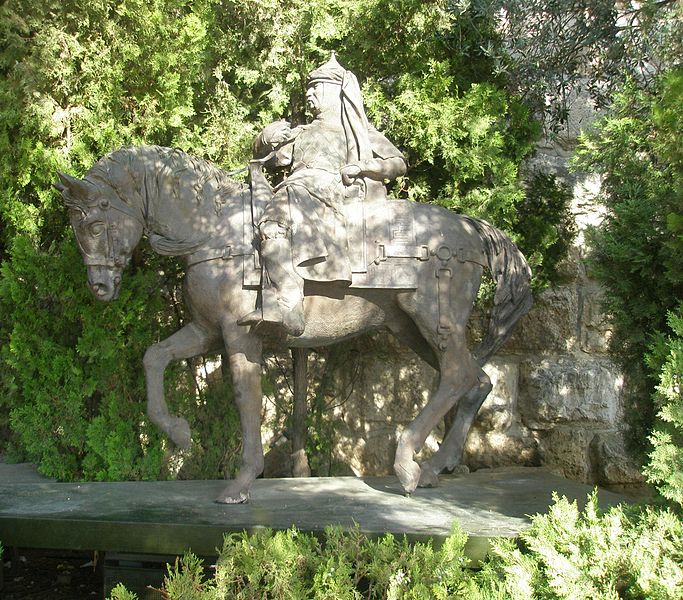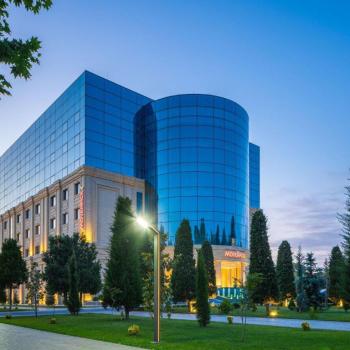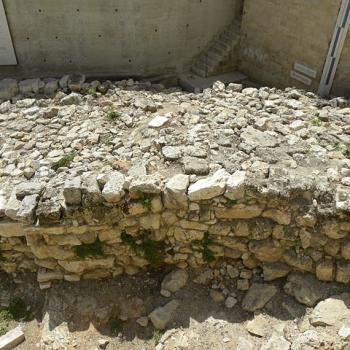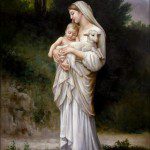
(Wikimedia Commons public domain image)
Overall, it can be said that the principal characteristic of the Middle Periods of Islamic history is political disintegration. Constantly shifting political boundaries made for instability and unceasing conflict. And the distinguishing mark of what Hodgson calls the Early Middle Period is, with the obvious exception of far-off Spain, Turkish domination. The Arabs had lost control of their own political destiny—something that would last for centuries and that has continued to rankle them well into our own time. A new ruling class had emerged, separated from the mass of the people and even from the learned classes by a different culture and a different language. Many of the rulers of the Middle Period never really learned to speak Arabic—much less to write it. The power of the amir (“commander,” later “prince”) rested on something similar to medieval European feudalism.[1] Unlike the European system, however, the amir seldom, if ever, lived on his own land. Instead, he lived in the capital and siphoned off the revenues of the rural areas to the city. The amir was often totally separated from local life, not only ethnically and linguistically, but even geographically. He gained legitimacy not from popular consent but from “recognition” by the caliph who, rather like today’s Queen of England, often had very little choice but to grant it.
Despite this political disintegration—or even, as I would argue, because of it—it is possible to consider the Early Middle Period the high point of Islamic civilization. The military commanders and princes of the small states competed one with another to attract the best poets and architects, knowing that the elegance of their courts and the quality of their architecture offered an important way to gain glory and fame. And this competition did, indeed, call forth an astonishingly high quality of work. Furthermore, apart from the role of patron, the rulers of these small states concentrated on military and diplomatic matters, leaving most people throughout the Islamic world free to do and act as they pleased, so long as there was no threat to the ruler’s political control.[2] An international society established itself across the Islamic world precisely because the political sphere and political institutions were reduced to a minimum. This laissez faire attitude led, predictably enough, to commercial expansion, to great prosperity, and to trade in the most varied luxury goods, which passed essentially unimpeded from China to Morocco. The majority of the population was Muslim by now, and Islam was central to all activities. Art and architecture flourished. This was also a period of great scientists and poets. If the Early Middle Period saw the rebirth of Persian literature, elegant Arabic likewise reached new heights. It was also an era of famous philosophers like Avicenna and Averroës.
How was the Islamic world able to maintain so much unity in the midst of political chaos and breakdown? Perhaps the crucial factor was the existence of the international class that we have called the ‘ulama’. These religious authorities, whom I have compared to Jewish rabbis, received the same education wherever they were. They read the same books, cited the same authorities, spoke the same language. Thus, they were able to stand above regional peculiarities and to transcend local politics. A Muslim religious judge could work equally well in Morocco or India or Egypt. And, in fact, some, like the great historian and social theorist Ibn Khaldun, actually did. The long period during which the ‘ulama’ had worked out their legal theories now paid off. The Islamic institutions that had been developed to function in opposition to the state now worked perfectly well in virtual independence of it and without regard to the constantly changing political situation that characterized the Middle Periods.
The illustrious Saladin, famous in the West as the chivalrous opponent of Richard the Lionheart, mercifully put an end to the long-sick Fatimid dynasty in the latter half of the twelfth century.[3] The last Shiite threat was gone. (It had actually died years before. Saladin merely signed the death certificate.) He eventually managed to drive the Crusaders out of Jerusalem as well and put an end to that Crusader state. A word about Saladin is timely here: He is widely regarded as a great Arab hero, and with good reason. (Even Dante Alighieri, devout medieval Christian that he was, put Saladin in the very highest circle of his Inferno among those virtuous heroes such as Hector, Socrates, Plato, Aeneas, Caesar, and his own guide through Hell and Purgatory, Virgil, whose only sin was that they had never received baptism.)[4] In still relatively recent memory, some Arabs—to say nothing of the dictator himself—tried to portray Iraq’s Saddam Hussein as the new Saladin. But there was no comparison. Beside the moral gulf that separated the two, there was yet another highly ironic difference: Although he spoke Arabic, Saladin was not ethnically an Arab, but a Kurd. Had he come back to life in the time of Saddam, it is true that Saladin might well have been ruling Baghdad. Not, however, in the role of Saddam Hussein, the butcher of Kurdish civilians. Instead, he would almost certainly have been their indignant avenger.
[1] Arabic amir (often spelled emir) is pronounced “a-MEER.”
[2] The distinction that Ronald Reagan’s ambassador to the United Nations, Jeanne Kirkpatrick (1926-2006), developed between “authoritarian” and “totalitarian” states is useful here: “Totalitarian” states—such as those of the Communists, the German Nazis, and the Italian Fascists—make a claim on every aspect of individual and social life. Art, literature, music, religion, the economy, all fields of human activity are subject to state interference and subservient to state aims. (The Church cannot function in such environments, until they at least begin to loosen up.) In “authoritarian” states, on the other hand, the ruler is inclined to let people do what they want, so long as they do not menace his rule. This is, by and large, the way things have sometimes shaped up during various times in places like Singapore, Korea, Taiwan, and many Latin American states (where the Church, on the whole, has functioned quite well even during politically rough periods). The states of the Early Middle Period clearly fit into the “authoritarian” category.
[3] Arabic Salah al-Din, pronounced Sa-LAAH ad-DEEN (with a strong “h“).
[4] Dante, Inferno, Canto IV, line 129.












